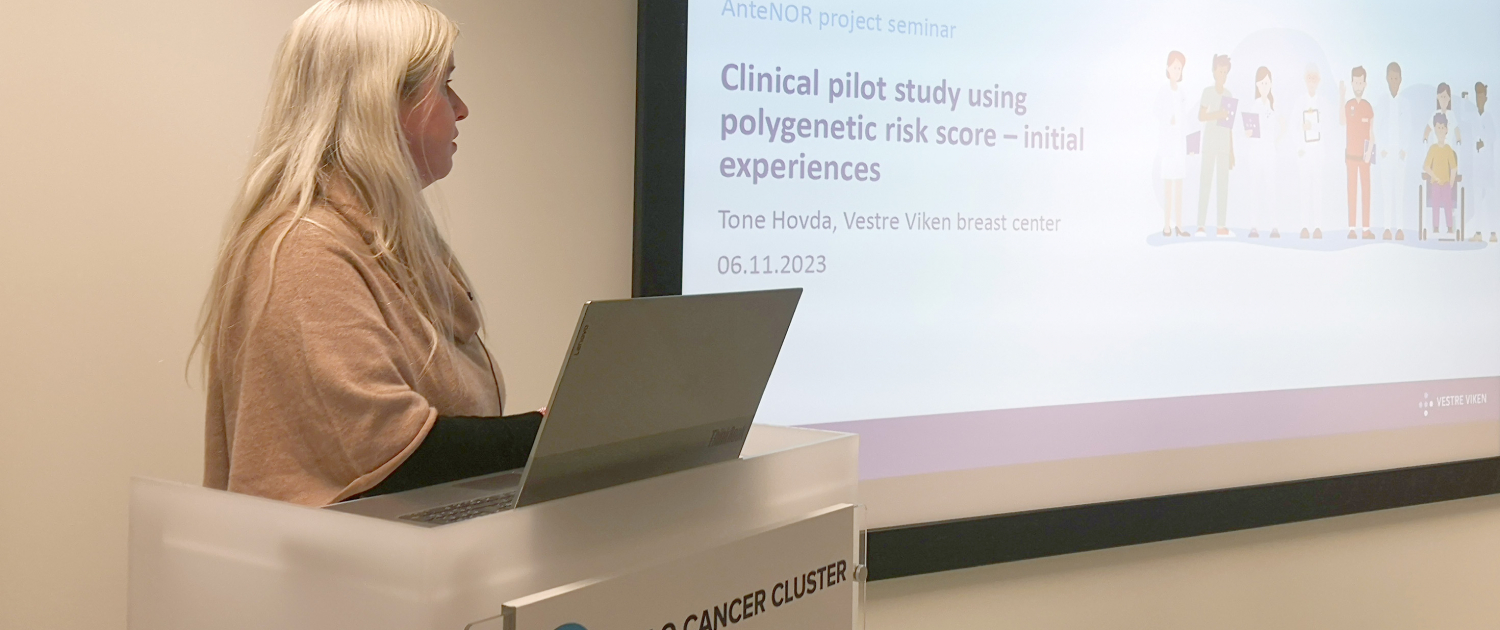Results from breast cancer screening pilot

A clinical pilot for personalised risk-based breast cancer screening has been conducted as part of the AnteNOR project. Here are some of the results.
The pilot study that was part of the AnteNOR research project investigated the use of a genetic test assessing the participants’ polygenic risk score (PRS) for breast cancer in tailoring a more personalised mammographic screening. Further, women’s experiences with the test were explored.
“In total, 80 women aged 40-50 years were included in the pilot study. They were recruited among women referred for clinical mammography at the breast center in Vestre Viken in Norway”, said Tone Hovda, senior radiologist at Vestre Viken Hospital Trust, where the study was conducted.
AnteNOR has investigated how it will be possible to implement a more personalised screening programme for breast cancer in Norway, based on the individual’s genetic risk for disease.
Women with a prior diagnosis of breast cancer or premalignant breast disease were excluded, as were women who had already been through genetic counselling and testing due to family cancer history.
The participants submitted saliva samples that were sent to the project partner Antegenes in Estonia for DNA sequencing and calculation of the polygenic risk score using the AnteBC test developed by Antegenes.
Screening recommendations
The participants were then recommended for future mammographic screening based on the results of the PRS test. The participant’s 10-year breast cancer risk was assessed and compared to the 10-year breast cancer risk for average women of the same age.
Women with a 10-year risk lower to or equal to average were recommended to participate in the national mammography screening program, BreastScreen Norway, inviting women aged 50-69 to biennial mammography. Women with a relative risk higher than average were recommended to start biennial mammographic screening at an earlier age than 50 years, based on what age the risk of an average 50-year-old woman was reached.
Women with a relative risk double as large as the average risk were recommended annual mammography from the age they reached a double risk compared to an average 50-year-old woman.
Half had a higher risk
In total, 51% had a relative risk for breast cancer based on the PRS-test that was higher than the average population of the same age. These participants were recommended to start mammography screening at an earlier age than 50. 12% had a relative risk double as large as the average risk.
27% were referred to the Oslo University Hospital for more extended genetic testing due to family cancer history.
Family cancer history
At inclusion, the participants answered a questionnaire addressing family cancer history. Medical geneticists at Oslo University Hospital evaluated this information, and participants fulfilling national criteria based on family cancer history were referred for further genetic counselling and testing for hereditary cancer, independent of the results of the PRS test.
What the women experienced
All participants were invited to answer a follow-up questionnaire 6-9 months after the PRS testing, exploring the women’s experiences.
“The vast majority felt it reassuring to get information about their future risk for breast cancer and agreed that they would probably follow the recommendations regarding mammography screening given based on the tests”, said Tone Hovda.
The participants were given written information about the test results and recommendations, and the majority agreed that this communication was satisfactory.
The pilot study provided important information for future studies exploring personalised risk-based breast cancer screening using the polygenic risk score as a measure for stratification.
“We plan to publish the results with more detailed analyses, also including breast density, as soon as possible in a peer-reviewed journal.
“Polygenic risk score is promising as part of a more risk-based personalised screening program for breast cancer. Other risk factors as breast density and family history should probably also be included. We definitely need larger prospective screening studies to gain further knowledge to move towards more personalised breast cancer screening rather than the current “one-size-fits-all” screening,” said Hovda.
Read more in this previous article about the clinical pilot.
Sign up for the upcoming seminar Results from the AnteNOR project: Norway’s way towards precision prevention
About AnteNOR
The project partners of AnteNOR are Oslo University Hospital, the University of Oslo, Vestre Viken Hospital Trust, Oslo Cancer Cluster and Antegenes. The project has received funding from the Norway Grants Green ICT programme and is finalized this year.
The clinical pilot has received approval from the regional ethics committee and is registered in the database clinicaltrial.gov.

The post Results from breast cancer screening pilot first appeared on Oslo Cancer Cluster.


